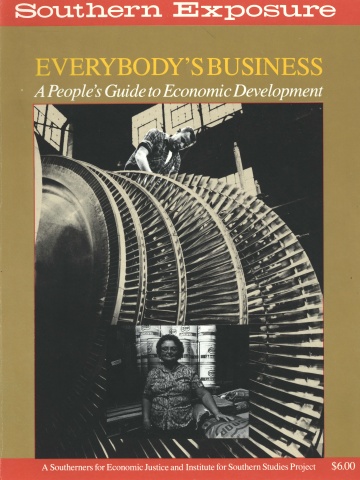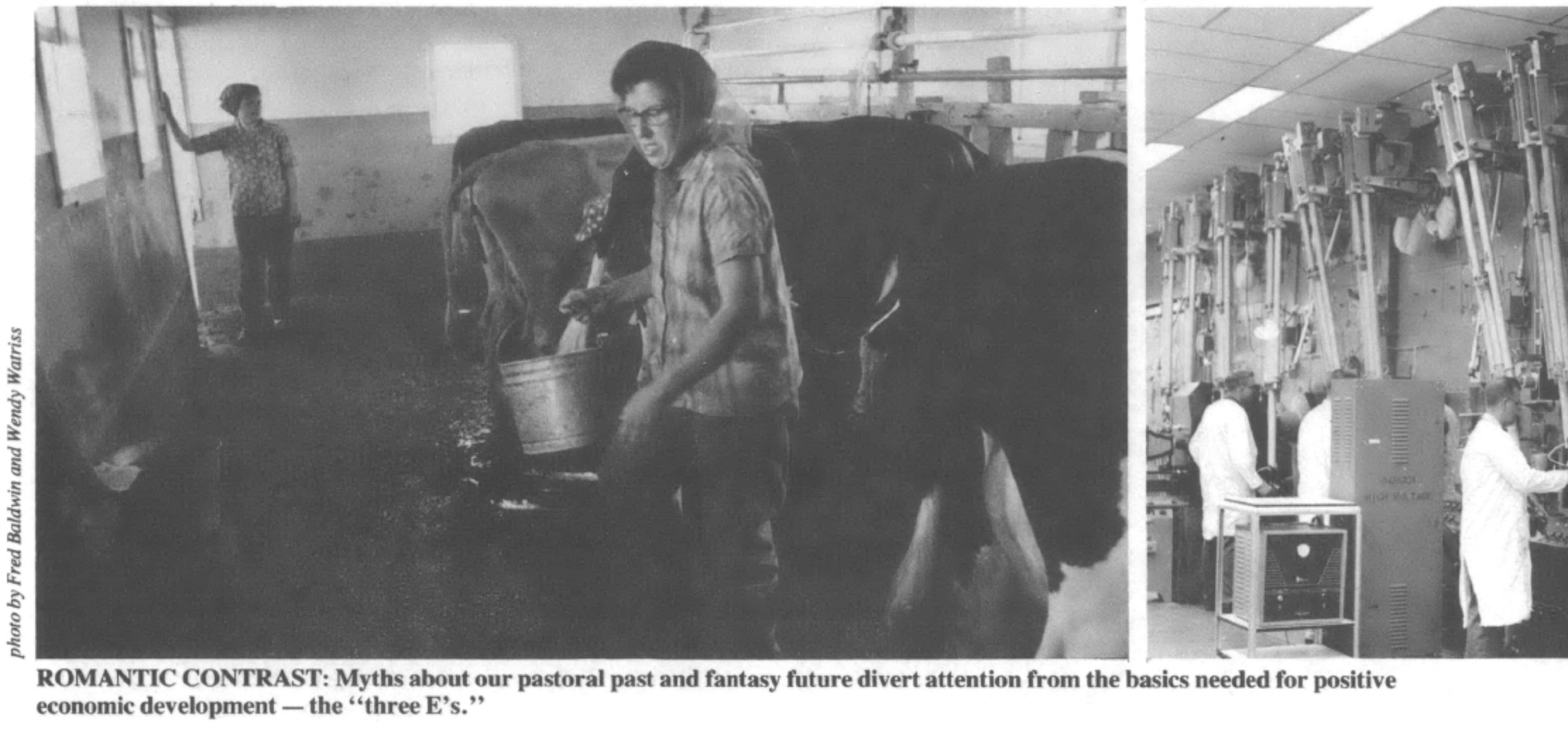
This article originally appeared in Southern Exposure Vol. 14 No. 5/6, "Everybody's Business." Find more from that issue here.
The economic plight of the South is, yet again, being "rediscovered." Two provocative reports released recently — After the Factories and Shadows in the Sunbelt — have been instrumental in reminding politicians and the media that many Southerners have not been reaping the benefits of the region's booming economy. Both studies point out that a distressing number of individuals and communities — especially in the rural South — are as bad off today as they were 20 years ago.
In fact, our nonmetropolitan communities may face even harder times than before. The two traditional mainstays of the South's rural economy — agriculture and manufacturing — are rapidly declining and neither shows much promise of recapturing its earlier prominence. Farm closings continue to displace rural families, while Southern landholdings become bigger and ever more concentrated. Meanwhile, new factories are not coming to the rural South in sufficient numbers to halt the hemorrhaging of its industrial base.
As the in-migration of branch plants has slowed to a trickle, so has the historic out-migration of the region's rural people. The South will no longer be able to export its rural poor, its inadequately educated, its surplus labor, or its less favored citizens to Northern cities. If a bus ticket north no longer can be considered a viable development strategy, what makes more sense? How can rural Southerners best build upon the resources at hand and begin to construct stronger local and regional economies?
In order to answer such questions, it is essential to understand the nature and consequences of previous economic initiatives. The history of rural development in our region — and across America — is simultaneously a stunning success story and a tragic tale. Both versions are true. The difference can be found in how development is conceived and measured.
Since World War II, rural development specialists in universities, government agencies, and the private sector have emphasized five fundamental strategies. Each has had its champions and its foes. Each has had places and periods of time in which it has been more popular than the other alternatives. Today as much as ever, these five strategies define what we, as a society, mean by the term "rural economic development."
The five strategies are:
Infrastructure Development — including construction of roads and highways, access to electricity and telephones, development of water and sewer systems, and the creation of industrial parks in the countryside.
Agribusiness — including an increasing emphasis on largescale, capital-intensive, chemically dependent farming, corporate ownership and vertical integration of the entire industry.
Industrial Recruitment — including the attempts to attract branch plants of traditional manufacturing firms and defense contractors, as well as research and development organizations, to rural areas.
Natural Resource Extraction and Processing — including the effort to modernize the mining, oil and natural gas, fishing, and timber/paper industries across the U.S. in order to compete more successfully in world markets and survive international competition for domestic markets.
Tourism and Recreation — including the creation of second home and retirement communities, vacation and resort areas and amusement parks.
The proponents and participants in each of these five development thrusts have ample reasons to boast. There is a multitude of success stories that can be told with great pride. Because of these efforts, the extraordinary physical endowments of rural America have been translated into a continuing source of wealth that is admired and envied throughout much of the world. Rural America (including the rural South) has long been, and remains today, the wellspring of our nation's economic productivity and prosperity.
Nevertheless, each of these five economic development strategies has had a "down side" story only rarely and reluctantly told in public. From pollution of the natural environment to the displacement of huge numbers of family farmers and mill workers, every success has been purchased at a significant price. Indeed, seen in a different light, these strategies begin to resemble the old joke about the operation being a success — even though the patient died.
The major contradiction — and abiding tragedy — of America's rural development is that most of the pain, but far too little of the pleasure, has accrued to non-elite indigenous rural residents. Over and over again, rural people and their communities have been forced to pay the price of "progress" and "economic changes and adjustments." Yet ordinary rural citizens have rarely been the primary beneficiaries of the programs carried out in their name and on their behalf.
A host of corporations have made fortunes year in and year out from rural labor and resources — at the same time that disproportionately high numbers of rural inhabitants struggle to make it on poverty (or near-poverty) level incomes. Government officials, academics, and private consultants continue to draw steady salaries and advance in their careers, even if the sector of society they "monitor," "study," and "advise" declines dramatically or folds completely. The rural "guinea pigs" at the end of our nation's policy pipeline enjoy no such protection from the consequences of their own (or their "public servants") actions. One Appalachian miner eloquently summed the situation up: "We're sitting on a gold mine and still starving to death."
The most important missing element in traditional development strategies is any serious respect for the integrity and intrinsic worth of rural people and rural communities. This is not entirely surprising, nor is this phenomenon exclusively a rural one. Our society as a whole puts the pursuit of profit and power ahead of the needs of "ordinary" people. However, in the rural context, this lack of respect has led to the rather bizarre situation in which "development" is most often done to rural communities rather than done by them — as well as one in which the lion's share of the benefits is gained by people other than the indigenous (or even resident) population of the community being "developed."
The Three "E"S of Development
The contradictions and distortions endemic to our current economic development strategies are neither inevitable nor intractable. If we so choose as a society, we can have a style of development that allows us not only to efficiently tap the abiding economic potential of our countryside, but also to do so in a manner that more democratically shares the decisionmaking powers and more equitably distributes the rewards.
There is an antidote to the sense of powerlessness, futility, and dependence engendered by an exploitative corporate sector and a public sector that seems to specialize in providing disabling help. The secret is to focus on the human side of development — and to begin with the conviction that the only development strategy worthy of the name is the kind that places the well-being of people and the quality of life above narrower calculations of corporate profit and political empire building.
There are three keys to unlocking genuine economic and human development. These keys are the three "E"s: empowerment, education, and entrepreneurship.
Empowerment in this context refers to the willingness and ability of people to take charge more fully of the development process. There is no guarantee, of course, that ordinary people will make "better" decisions or wiser judgments than those now made both within and outside government. That is not the point. History teaches that if there is a penalty or a price to be paid for mistakes made in the course of implementing any rural development plan, the local residents will bear this burden; it is no more than simple justice that theirs should be the prevailing voice in the decisions about what plans to implement.
Although empowerment cannot be given or legislated, it can be encouraged and nurtured. Education (broadly defined) has the potential to be the mechanism through which rural empowerment in the development process is fostered. Indeed, education could be the decisive factor in turning around both the counterproductive attitudes of our society (including rural people themselves) toward rural development and the distorted priorities we've come to accept as normal.
In order for education to accomplish this task, it must go well beyond its current repertoire of activities and functions. All too often, education has been limited to the provision of "basic skills" and the preparation of ever-better job applicants. Worse, it has served as one of the agencies socializing rural people (young and old) toward passivity, docility, low aspirations, low self-esteem, and fatalism about the future of their communities — the very traits that must be overcome if empowerment is to be achieved.
Fortunately, there are existing and successful models of educational initiatives and institutions in our region that have been promoting rural empowerment. These range from rural school-based enterprises in Georgia and North Carolina to the Foxfire program to the Highlander Center to the network of Southern rural institutions affiliated with the Association for Community-Based Education. None of these has all the answers, but each has pioneered valuable new ways for education to do more than pay lip-service to the most pressing needs of their rural learners. In fact, efforts such as these demonstrate why education should be (and how it can be) one of the top development priorities.
The third and final key to rural development worthy of the name is entrepreneurship. Under this umbrella are self-employed individuals, inventors, cottage industries, worker-owned enterprises, cooperatives, community development corporations, family farmers, and the myriad of small owner-operated businesses scattered throughout the rural South. Although often overlooked or viewed with disdain by big-time economists, planners and development officials, this sector of the rural economy already plays a crucial role in the sustenance and vitality of nonmetropolitan life — and could play an even greater role in the future.
One of the unexpected blessings of rural life today is that the same communities that offer relatively few good job opportunities usually have a variety of good untapped economic opportunities. Obviously, this fact bodes well for the continued survival and economic health of our countryside — if we are able to identify these opportunities and bring them to fruition.
Two challenges, however, must be surmounted. The first is that rural people in general — and rural youth, women, and minorities in particular — are very rarely given the encouragement, training, and technical assistance they require to become successful entrepreneurs of any type. The second challenge is that the prime economic opportunities in an area are often snapped up by outside investors and absentee owners. Again, training and assistance in analyzing the economic potential of one's own community is indispensable — and so is effective access to capital.
"Growth from within" must be coupled with appropriate financial and technical assistance from outside the rural communities concerned. Any sensible state or national campaign for genuine rural development must make indigenous entrepreneurship, along with empowerment and education, the new top priorities for the remainder of this century. With that emphasis, rural Southerners can at long last create and implement their own visions of economic development worthy of the name.
Tags
Jonathan Sher
Dr. Jonathan P. Sher is president of Rural Education and Development, Inc. in Chapel Hill, North Carolina. He works with rural communities to establish school-based enterprises. This article is adapted from a piece appearing in New Dimensions in Rural Policy: Building Upon Our Heritage (Washington, D.C.: Joint Economic Committee of Congress, 1986). (1986)

